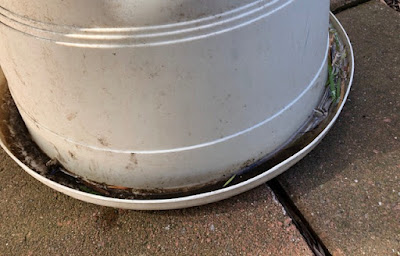
Very wet week could create soggy conditions

|
|
Rain will create pooling of water in container saucers,
so be sure to remove the saucers before the storm hits.
(Photo: Kathy Morrison)
|
Expect to get wet. After fretting over lack of winter rain, Sacramento will soak up what could be a month’s worth of precipitation between now and Tuesday night.
Estimates by the National Weather Service show 3 to 4 inches expected in Sacramento, 5 to 7.5 inches in Grass Valley. Most of the rain will be slow and steady as part of an atmospheric river.
“The main impacts from this moderate to heavy rain will be ponding on roadways and minor flooding in areas of poor drainage,” tweeted the weather service’s Sacramento office on Saturday morning.
More rain could follow on Wednesday and Thursday until the sun finally breaks through Friday, says the weather service.
Historically, December averages 3.5 inches of rain in Sacramento. Accompanied by heavy snow in the Sierra, this pre-Christmas deluge likely will get our water year back on track and alleviate some drought fears.
Such prolonged rain also will create soggy conditions in the garden. Hold off on transplanting bare-root roses, trees and berries until the soil has a chance to dry out.
* Protect potted poinsettias from cold and wet; they prefer it dry with temperatures in the high 60s, just like most people. Keep poinsettias in a sunny, warm location. Water thoroughly. After the holidays, feed your plants with a low-dose fertilizer monthly so they’ll bloom again next December.
* Make sure to poke holes in any foil wrapping around gift plants to allow drainage.
* Remove saucers under outdoor potted plants to avoid pooling of water and potential rot.
* Avoid walking on soggy soil; it compacts the soil – bad for roots and microorganisms.
* Keep gutters clear so storm water doesn’t pool or flood.
* Keep an eye on big trees, especially evergreens. Their foliage soaks up rain and puts a lot of extra weight on limbs. Redwoods in particular may become unstable due to root loss during drought. If a tree starts leaning, call an arborist.
* Just because it rained doesn't mean every plant got watered. Give a drink to plants that the rain didn't reach, such as under eaves or under evergreen trees.
* Clean and sharpen garden tools before storing for the winter.
Comments
0 comments have been posted.Sacramento Digs Gardening to your inbox.
Sites We Like
Garden Checklist for week of May 5
Survey your garden after the May 4 rainstorm. Heavy rain and gusty winds can break the neck of large flowers such as roses. Also:
* Keep an eye on new transplants or seedlings; they could take a pounding from the rain.
* Watch out for powdery mildew. Warmth following moist conditions can cause this fungal disease to “bloom,” too. If you see a leaf that looks like it’s dusted with powdered sugar, snip it off.
* After the storm, start setting out tomato transplants, but wait on the peppers and eggplants (they want warmer nights). Pinch off any flowers on new transplants to make them concentrate on establishing roots instead of setting premature fruit.
* Trim dead flowers but not leaves from spring-flowering bulbs such as daffodils and tulips. Those leaves gather energy to create next year's flowers. Also, give the bulbs a fertilizer boost after bloom.
* Pinch chrysanthemums back to 12 inches for fall flowers. Cut old stems to the ground.
* Mulch around plants to conserve moisture and control weeds.
* From seed, plant beans, beets, cantaloupes, carrots, corn, cucumbers, melons, pumpkins, radishes and squash.
* Plant onion sets.
* In the flower garden, plant seeds for asters, cosmos, celosia, marigolds, salvia, sunflowers and zinnias. Transplant petunias, zinnias, geraniums and other summer bloomers.
* Plant perennials and dahlia tubers for summer bloom.
* Don’t wait; plant summer bulbs, such as gladiolus and tuberous begonias.
* Harvest cabbage, lettuce, peas and green onions.